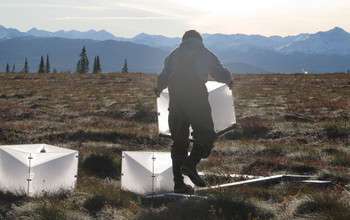Life on Earth: National Science Foundation awards $23 million for studies of planet's biodiversity

Rapid changes are happening in the Arctic: ice cover is shrinking, permafrost is thawing. But what's happening to ground-dwelling species such as mosses?
Mosses are critical parts of nutrient cycles in the far north, scientists say. For example, microbes that live on mosses are the major source of nitrogen for plant growth in boreal and tundra ecosystems. Yet many aspects of these plant communities are poorly understood.
Through a new National Science Foundation (NSF) Dimensions of Biodiversity grant, Stuart McDaniel of the University of Florida and colleagues will use moss-microbe interactions to understand how biodiversity shapes high-latitude ecosystems.
The project is one of 10 funded this year through NSF's Dimensions of Biodiversity Program.
A total of $23 million has been invested in the grants, with contributions from NSF's directorates for Biological Sciences and Geosciences, as well as the National Natural Science Foundation of China (NSFC) and the Sao Paulo Research Foundation of Brazil (FAPESP).
The Dimensions of Biodiversity Program is unique in its approach. In contrast to traditional biodiversity research that focuses on one taxonomic group or ecosystem, Dimensions of Biodiversity integrates multiple areas of study into research projects.
The program links functional, genetic and phylogenetic/taxonomic dimensions of biodiversity, offering opportunities to produce rapid advances in understanding the creation, maintenance and loss of biodiversity.
"This year's Dimensions of Biodiversity investigators join an international and multidisciplinary network of scientists who, through cutting-edge and integrative approaches, are transforming our understanding of biodiversity," says James Olds, assistant director for NSF's Biological Sciences directorate.
The research will fill in gaps in biodiversity knowledge, scientists say. It also has the potential to lead to significant progress in agriculture, fuel, manufacturing and health.
For example, plant and animal extinctions are detrimental to human health, scientists have found. Species losses in ecosystems such as forests and fields result in increases in pathogens, or disease-causing organisms. The species most likely to disappear as biodiversity declines are often those that buffer infectious disease transmission. Those that remain tend to be ones that magnify diseases such as West Nile virus and Lyme disease.
Economic sustainability also depends on the diversity of life on Earth. Many industrial materials, such as fibers and dyes, come from biological sources. In addition, biodiversity is important to such resources as water, food and pharmaceuticals.
To conserve Earth's biodiversity, scientists funded through the Dimensions of Biodiversity program are working to better understand interactions among species from microbes to mosses, lichens and marine life.
"Understanding the diversity of life on land and in the sea is critical as our environment changes," says Roger Wakimoto, assistant director for NSF's Geosciences directorate. "This year's Dimensions of Biodiversity projects include important but poorly known branches of animals and microorganisms in understudied regions of the oceans."
The new Dimensions of Biodiversity projects focus on topics including: the diversity of ctenophores, or comb jellies, in the deep sea; lichens in a global diversity hotspot; microbial communities living on suspended and sinking particles in marine oxygen-deficient zones; moss microbiomes in rapidly changing Alaskan ecosystems; and pollination in Penstemon, or beardtongues, a large genus of North American and East Asian flowering plants.
2015 Dimensions of Biodiversity Awards
- Martha Condon, Cornell College: Dimensions: Collaborative Research: Diversification Dynamics of Multitrophic Interactions in Tropical Communities
- Peter Girguis, Harvard University: Dimensions: The phylogenetic and functional diversity of extracellular electron transfer across all three domains of life
- Steven Haddock, Monterey Bay Aquarium Research Institute: Dimensions: Life at extremes: Linking the phylogenetic and genomic diversity of ctenophores to ecophysiological adaptations in the deep sea
- Lena Hileman, University of Kansas: Dimensions: The evolution of pollination syndrome diversity in Penstemon
- James Lendemer, New York Botanical Garden: Dimensions: Biodiversity Gradients in Obligate Symbiotic Organisms: A Case Study in Lichens in a Global Diversity Hotspot
- Stuart McDaniel, University of Florida: Dimensions: Collaborative Research: Community genomic drivers of moss microbiome assembly and function in rapidly changing Alaskan ecosystems
- Matthew Olson, Texas Tech University: Dimensions US-China: Allosomes and dioecy in plants as drivers of multi-level biodiversity
- Tammi Richardson, University of South Carolina: Dimensions: Links Between Spectral Irradiance and Cryptophyte Biodiversity in Environments from Ponds to Oceans
- Gabrielle Rocap, University of Washington: Dimensions: Diversity, assembly and function of microbial communities on suspended and sinking particles in a marine Oxygen Deficient Zone
- Brett Tyler, Oregon State University: Dimensions: Dynamical interactions between plant and oomycete biodiversity in a temperate forest
Provided by National Science Foundation